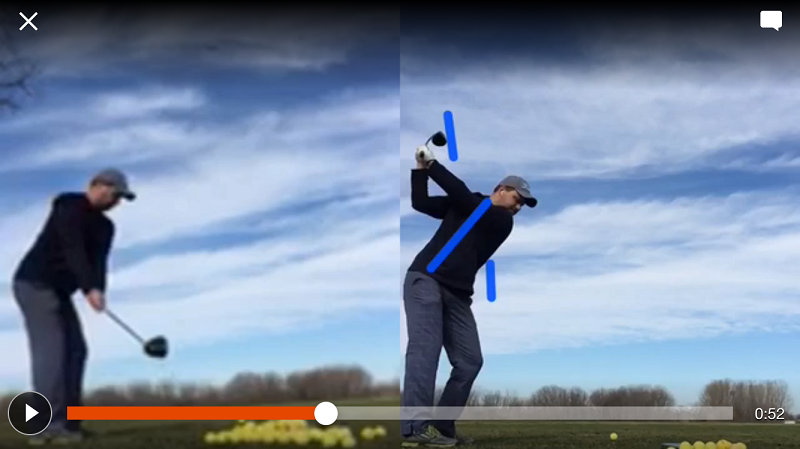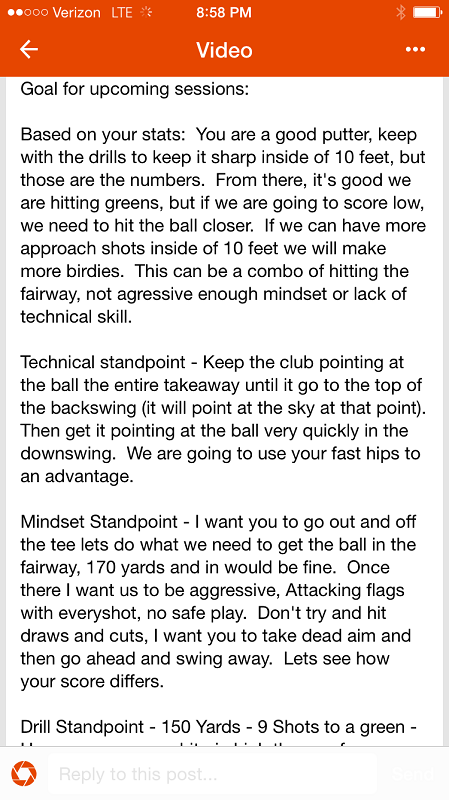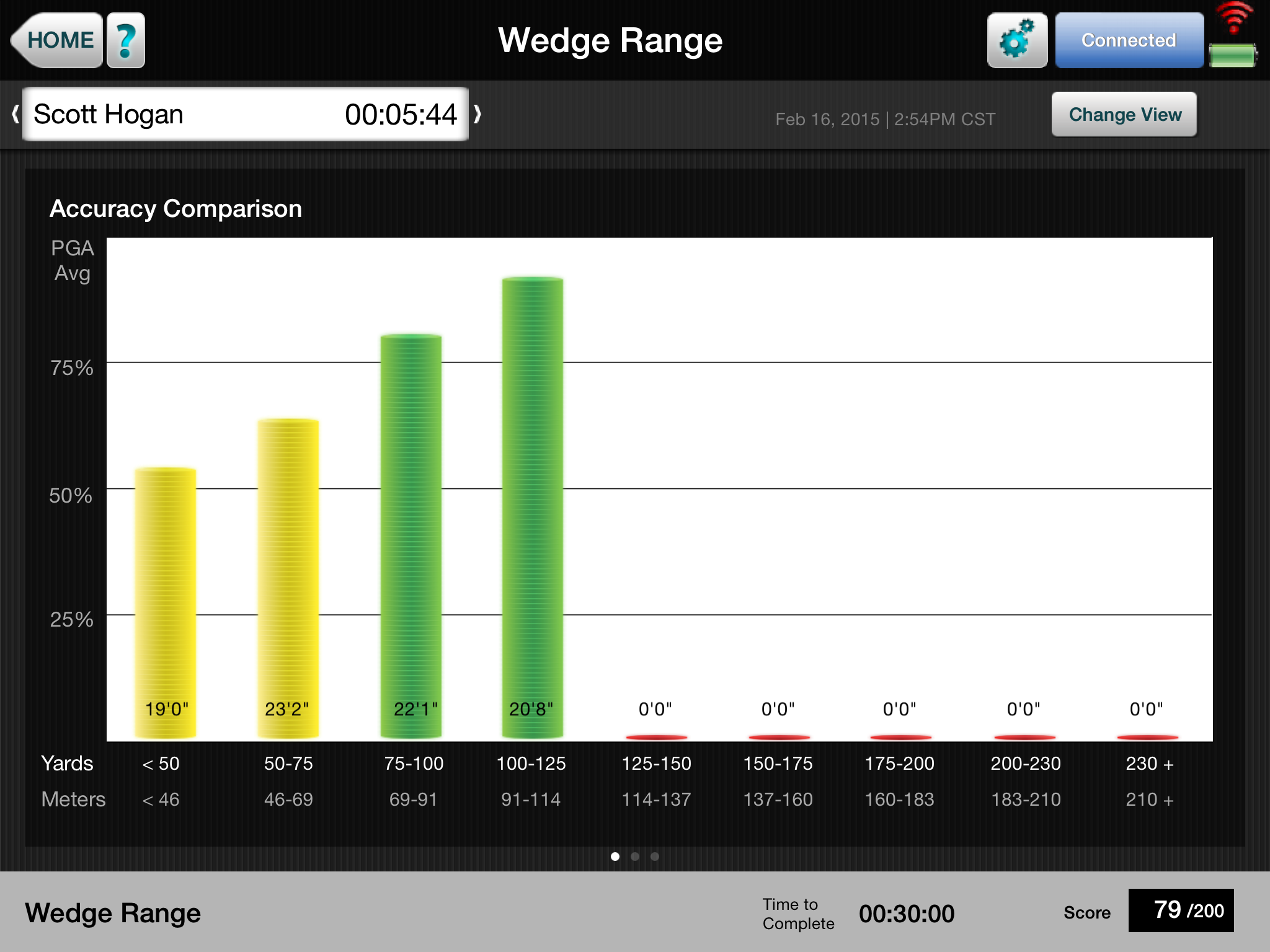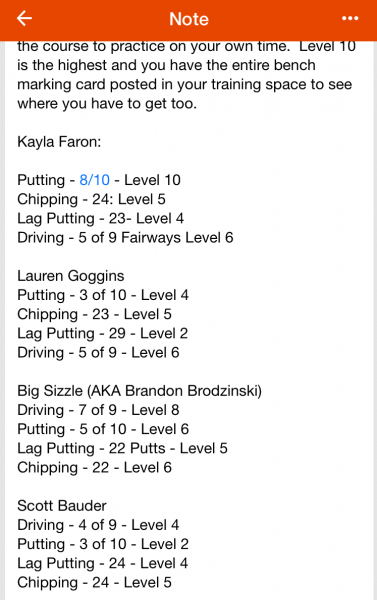Instruction
Connected Coaching: Take advantage of technology to improve rapidly

As a golf coach, I love technology. Learning about the science behind the golf swing is extremely interesting, and I love to look at the club and ball data from my students, as well as their pressure trace and kinematic sequence graph to show what is truly going on in their golf swings. But all of this data is only a small portion of what it takes to improve your golf game, and with a majority of my students, something that is low on the priority list when it comes to shooting lower scores.
Technology has allowed me as a coach to use it in a more important manner, and it has given me the ability to stay connected to my students throughout the coaching process. With the creation of mobile coaching platforms such as Edufii, I am able to better help my students stay focused on what they should be working on when they are practicing on their own, and also introduce some much needed elements of development that they may be missing.
Below are a few examples of how I use technology and the Edufii coaching platform to help my students improve and keep them connected to their improvement, even when they are not at the golf course.
Understanding Their Game
One of the greatest challenges I have as a coach is getting accurate feedback about a student’s game from the student themselves. Golfers tend to be very biased about their golf games and can make themselves believe they need to work on one area of their game, when in reality there is some very low-hanging fruit to be seized by working on another.
When my students play golf, they have access to a scorecard that accurately identifies their skill levels based on their skill level. This is very important, because there are a lot of golfers who keep stats, but keep them based on what they see the best players in the world doing. This would be OK if they were a tour player, but someone trying to break 100 for the first time needs to have stats that are relevant to their skill level.
With Edufii, my students can fill out their scorecard and upload it to me right after their round, along with some quick thoughts about what they felt while playing. Again, this is very important in helping to understand what is truly going on in their game. I will also ask them to upload scorecards of good rounds, good swings or days when they felt their thoughts were good.
Practice Makes Permanent, So Make It Perfect

With video analysis software, a student (from anywhere) can send me a video and I can provide instant feedback.
Anyone who has attempted to make a technical correction to their golf swing knows how painful it can be sometimes. After getting a lesson, we head to the range, start hitting balls and wonder if we are still making the correct golf swing.

With Edfuii’s remote coaching platform, I can layout a detailed plan of attack.
Technology improves the process, first by allowing me to post a student’s lesson in a training space where it can be accessed from their cell phone, tablet or computer. They can be reminded of what they should be working on and any drills they need to perform to make sure they are making the correct golf swing. It also allows students to send videos back to me for review. If a student is struggling with a swing change or wants confirmation of their technique, they have the ability to film and upload a video that I can analyze and then return to them with comments.
This is very helpful in making sure that any time spent practicing is used in the most efficient manner. It also makes it very convenient for me to help students from anywhere in the country, and even internationally — not just when they are physically present.
Compete Against Like-Minded Individuals
One of the most underused, yet maybe the most important aspect of implementing changes is working to transfer skills from the practice facility to the golf course. I hear it all the time from professional and amateur golfers. They talk about how well they hit the ball on the range, but on the course it all went wrong.

A wedge range challenge that gives golfers a score so they can monitor their progress.
Golf is a great game because it allows us to always be competing, whether we are playing to win a tournament or trying to make our first par ever. Nerves and fear are often present in these situations, so if we are going to overcome the pressure that builds in every round of golf we need to start practicing with some pressure. My favorite way to do this is through competition. Most golfers, however, do not have someone they can compete against on a regular basis.

Reports for players in different aspects of their game
Technology has allowed me to connect my students to other students looking to get better and allows them to complete challenges to see who can score best. An example would be a student who wanted to complete a wedge range challenge (see the photo above) to see how he stacked up against other golfers.
It also allows me to establish weekly scoreboard challenges where students can see where other golfers excel, which may allow them to understand better what areas they need to improve on to obtain their desired scores.
Technology has had a huge impact on our understanding of the golf swing, but that is only a small part to shooting lower scores. Get the most of what technology has to offer with connected coaching, and you can start to improve faster and make 2015 your best golfing year ever.
*Join Scott Hogan’s group – The Legion of Birdies – by clicking here. It is free to join, and you will gain access to drills, performance challenges and more.
- LIKE16
- LEGIT2
- WOW3
- LOL1
- IDHT2
- FLOP2
- OB1
- SHANK14
Instruction
Clement: Weak grips are injuries in the making for many golfers

Like Jordan Spieth, trying to go to a bowed wrist at the top or in the downswing to square the club is placing you in a dangerous position for your lead wrist; you are one tree root or deep rough situation away from a nasty injury that could easily require surgery. Don’t let this be you.
- LIKE1
- LEGIT0
- WOW0
- LOL0
- IDHT1
- FLOP2
- OB0
- SHANK3
Instruction
Clement: Laid-off or perfect fade? Across-the-line or perfect draw?

Some call the image on the left laid off, but if you are hitting a fade, this could be a perfect backswing for it! Same for across the line for a draw! Stop racking your brain with perceived mistakes and simply match backswing to shot shape!
- LIKE2
- LEGIT0
- WOW0
- LOL0
- IDHT0
- FLOP0
- OB0
- SHANK1
Instruction
The Wedge Guy: The easiest-to-learn golf basic

My golf learning began with this simple fact – if you don’t have a fundamentally sound hold on the golf club, it is practically impossible for your body to execute a fundamentally sound golf swing. I’m still a big believer that the golf swing is much easier to execute if you begin with the proper hold on the club.
As you might imagine, I come into contact with hundreds of golfers of all skill levels. And it is very rare to see a good player with a bad hold on the golf club. There are some exceptions, for sure, but they are very few and very far between, and they typically have beat so many balls with their poor grip that they’ve found a way to work around it.
The reality of biophysics is that the body moves only in certain ways – and the particulars of the way you hold the golf club can totally prevent a sound swing motion that allows the club to release properly through the impact zone. The wonderful thing is that anyone can learn how to put a fundamentally sound hold on the golf club, and you can practice it anywhere your hands are not otherwise engaged, like watching TV or just sitting and relaxing.
Whether you prefer an overlap, interlock or full-finger (not baseball!) grip on the club, the same fundamentals apply. Here are the major grip faults I see most often, in the order of the frequency:
Mis-aligned hands
By this I mean that the palms of the two hands are not parallel to each other. Too many golfers have a weak left hand and strong right, or vice versa. The easiest way to learn how to hold the club with your palms aligned properly is to grip a plain wooden ruler or yardstick. It forces the hands to align properly and shows you how that feels. If you grip and re-grip a yardstick several times, then grip a club, you’ll see that the learning curve is almost immediate.
The position of the grip in the upper/left hand
I also observe many golfers who have the butt of the grip too far into the heel pad of the upper hand (the left hand for right-handed players). It’s amazing how much easier it is to release the club through the ball if even 1/4-1/2″ of the butt is beyond the left heel pad. Try this yourself to see what I mean. Swing the club freely with just your left hand and notice the difference in its release from when you hold it at the end of the grip, versus gripping down even a half inch.
To help you really understand how this works, go to the range and hit shots with your five-iron gripped down a full inch to make the club the same length as your seven-iron. You will probably see an amazing shot shape difference, and likely not see as much distance loss as you would expect.
Too much lower (right) hand on the club
It seems like almost all golfers of 8-10 handicap or higher have the club too far into the palm of the lower hand, because that feels “good” if you are trying to control the path of the clubhead to the ball. But the golf swing is not an effort to hit at the ball – it is a swing of the club. The proper hold on the club has the grip underneath the pad at the base of the fingers. This will likely feel “weak” to you — like you cannot control the club like that. EXACTLY. You should not be trying to control the club with your lower/master hand.
Gripping too tightly
Nearly all golfers hold the club too tightly, which tenses up the forearms and prevents a proper release of the club through impact. In order for the club to move back and through properly, you must feel that the club is controlled by the last three fingers of the upper hand, and the middle two fingers of the lower hand. If you engage your thumbs and forefingers in “holding” the club, the result will almost always be a grip that is too tight. Try this for yourself. Hold the club in your upper hand only, and squeeze firmly with just the last three fingers, with the forefinger and thumb off the club entirely. You have good control, but your forearms are not tense. Then begin to squeeze down with your thumb and forefinger and observe the tensing of the entire forearm. This is the way we are made, so the key to preventing tenseness in the arms is to hold the club very lightly with the “pinchers” — the thumbs and forefingers.
So, those are what I believe are the four fundamentals of a good grip. Anyone can learn them in their home or office very quickly. There is no easier way to improve your ball striking consistency and add distance than giving more attention to the way you hold the golf club.
More from the Wedge Guy
- The Wedge Guy: Golf mastery begins with your wedge game
- The Wedge Guy: Why golf is 20 times harder than brain surgery
- The Wedge Guy: Musings on the golf ball rollback
- LIKE93
- LEGIT16
- WOW6
- LOL1
- IDHT0
- FLOP4
- OB1
- SHANK9
-

 Product Reviews2 weeks ago
Product Reviews2 weeks agoThree Swing Challenge: Testing the Edel Array F-2 putter
-

 Equipment2 weeks ago
Equipment2 weeks agoWhat clubs do equipment free agents choose to use on tour? We found out
-

 News3 weeks ago
News3 weeks agoHighlights from the Wilson Golf Product Testing and Fitting Experience at Pinehurst
-

 News3 weeks ago
News3 weeks agoDavis Thompson’s winning WITB: 2024 John Deere Classic
-

 19th Hole2 weeks ago
19th Hole2 weeks agoMajor champ ‘disappointed’ not to be chosen as U.S. Ryder Cup captain
-

 Whats in the Bag5 days ago
Whats in the Bag5 days agoXander Schauffele’s winning WITB: 2024 Open Championship
-

 19th Hole3 weeks ago
19th Hole3 weeks agoIan Poulter explains decision to skip Open Championship qualifying
-

 19th Hole2 weeks ago
19th Hole2 weeks agoLIV pro explains how he believes players are ‘cheating’ on DP World Tour



















Jafar
Jul 13, 2015 at 11:15 am
I was looking for some online coaching. I think a teacher who can analyze a swing and give some feedback and reasoning is still better than just using a Trackman.
Steve
Jul 12, 2015 at 11:03 pm
Why do i need you? In alittle time a computer will read the data and offer what is needed to correct the faults. Why will you be needed? All you trackman teachers are on borrowed time.
I love that you embrace technology that in time will eliminate your job.
Mike
Jul 13, 2015 at 12:39 pm
I totally DISAGREE. Can you improve on your own without a coach? Yep, most definitely. That said a new set of eyes often brings a new way of explaining what he’s seeing. Golf books continue to be written because everyone understands things differently–one person explains and understands things differently than another.
Steve
Jul 13, 2015 at 4:17 pm
I understand what you are saying. But in recent years there is a new wave of teaching, that depends on trackman data. They dont even watch your swing, they watch the computer.
That is why Harmon is the king, he doesnt depend on a computer to tell him what to do.
Jeremy
Jul 13, 2015 at 5:40 pm
Judging from the tone of your comment, it doesn’t surprise me that you’re more inclined go it alone and have a computer tell you how to improve. Some people like getting advice and feedback from other humans. Whatever works is fine, but there’s no need for rudeness.